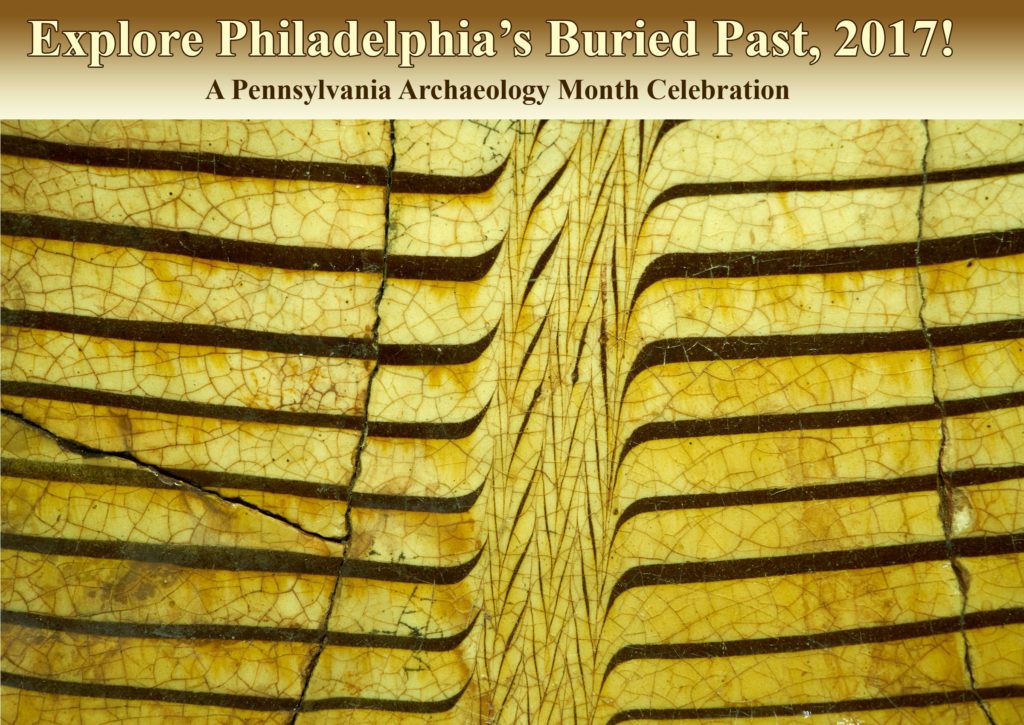Program Schedule: Explore Philly’s Buried Past, 2017! (PAST EVENT)
See Past Events
(PAST EVENT)
Discover the history beneath your feet!
See the latest archaeological artifacts found in our area!
SATURDAY OCTOBER 7TH (10AM-3:30PM)
FREE event! Open to All!
‘Stop in’ or stay all day.
No reservation required.
Co-sponsored by Independence National Historical Park
and the Philadelphia Archaeological Forum
VENUE: National Constitution Center
Kirby Auditorium (2nd fl) 525 Arch Street (Parking/Directions…)
+++++++++++++++++++++++++++++++++++++++++++++++++++
(PAST EVENT)

10:00am-10:15am
Welcome
Jed Levin, Chief, History Branch, Independence National Historical Park
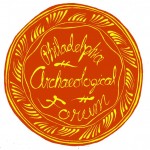
10:15am-10:30am
Philadelphia Archaeology: Year in Review
Douglas Mooney, President, Philadelphia Archaeological Forum
A whirlwind tour of projects and other notable developments in Philadelphia archaeology during the past year.
10:30am-10:45am
What the Coffins and Skeletons  Excavated at 218 Arch Street Tell Us About the First Baptists in Philadelphia
Excavated at 218 Arch Street Tell Us About the First Baptists in Philadelphia
Last year a construction project destroyed portions of the long lost, historical, First Baptist Church Cemetery (1700-1860). George Leader of the University of Pennsylvania, Kimberly Moran of Rutgers University, Jared Beatrice of the College of New Jersey, and Anna Dhody of the Mutter Research have been analyzing the excavated skeletons as well as the various items buried along with individuals in their wooden coffins. This talk presents some of what has been learned about the some of the city’s first Baptists and their burial practices.
 10:45am-11:00am
10:45am-11:00am
Save Our Sites: Heritage at Risk
Douglas Mooney, President, Philadelphia Archaeological Forum
What is the Philadelphia Archaeological Forum doing to help save the historical burial grounds and other archaeological sites in Philadelphia– and what can you do to help?
11am-11:05am
RAFFLE
11:05am-11:20am
Lightening Round #1
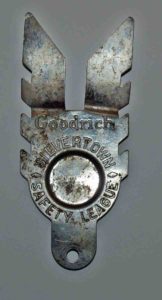
11:05am-11:08am
Join the Safety League: Safety and Advertising in the Early Twentieth Century
While conducting an archaeological investigation at the site of an early twentieth century farm site, Ken Basalik (President of Cultural Heritage Research Services, Inc.) excavated a license plate topper. This artifact reveals how the idea of ‘safety’ was used in the world of advertising to push products.
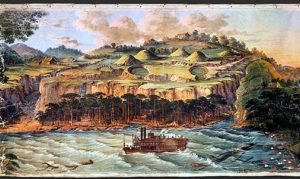
11:09am-11:12am
Montroville W. Dickeson and the Origins of PowerPoint
Montroville W. Dickeson was a Philadelphia physician who spent the mid-19th century collecting archaeological materials from Native American mound sites in the South. Now his collection is housed in the Penn Museum, but before the objects ended up there, he took them on a nation-wide tour, lecturing about their importance to understanding U.S. prehistory. To illustrate his lecture, he commissioned a painter to create a 350′-long panorama which scrolled behind him as he spoke, functioning like an early version of PowerPoint. (Meg Kassabaum, Assistant Professor, Department of Anthropology, Weingarten Assistant Curator for North America, Museum of Archaeology and Anthropology, University of Pennsylvania)
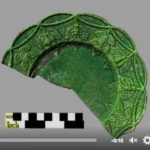 11:13am-11:16am
11:13am-11:16am
A Tale of Two Scans
This talk by Christopher Francis (STAR Scholars Program, Pennoni Honors College, Drexel University) tells the tale of two 3-Dimensional image scans made of half a broken plate. The two scanning efforts are separated by a period of 9 years and reflect the changes in cutting edge technology that can be used to help interpret the past. The broken plate is associated with James Oronoco Dexter’s occupation of a house site excavated by archaeologists during construction of the National Constitution Center. Dexter was a manumitted slave who was active in the first free African American community in late 18th/early 19th century Philadelphia. The new 3-D plate scan will become part of a virtual recreation of the Dexter House.
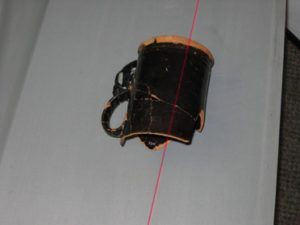
11:17am-11:19am
I’ll Toast to That!
This presentation by Ethan Graham (STAR Scholars Program, Pennoni Honors College, Drexel University) demonstrates how a 2008 3Dimensional scan of the remains of a redware tankard is being used to virtually repair the artifact. The tankard was recovered from the James Oronoco Dexter house archaeological site that today lies under the National Constitution Center bus depot. The virtually repaired tankard recreation will be used in a virtual reality role-playing game that will explore religion, race, and class in late 18th century Philadelphia –and in their 21st century legacies.
11:20am-11:35am
Northern Delaware and Southeastern Pennsylvania’s White “Kaolin” Clays
The clay soils of the White Clay Creek Valley in Southeastern PA/Delaware led to the development of quarries, mines, kilns, and pottery businesses active from the 18th through the 20th centuries. Drawing upon recent archaeological investigations at the site of the Newark China Clay Company, Bill Liebeknecht and Kristi Chase of Dovetail Cultural Resource Group present new findings about this local clay industry.
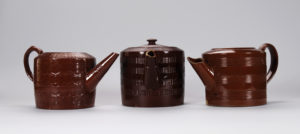
11:35pm-11:50am
Ornamental Origins: Philadelphia Manufactured Ceramics with Engine-Turned Decoration
In the early 19th century, Philadelphia potters began experimenting with new technology to produce ceramics that were nearly indistinguishable from those imported from England. This presentation will explore these innovative techniques through the ceramics vessels they produced. Deborah Miller (Archaeologist/Material Culture Specialist
at AECOM) will share a variety of the patterns, forms, and shapes of these ceramic vessels that have only been recovered from archaeological sites in Philadelphia.
11:50am-12:00 noon
RAFFLE and ASK THE ARCHAEOLOGIST/Questions and Discussion with the Audience
……………………………………
12:00 noon-1:30pm
LUNCH on your own
Special Lunchtime Small Group Tours:
Touch the Archaeological Past in the NCC’s Newly Refurbished “We The People” Exhibit
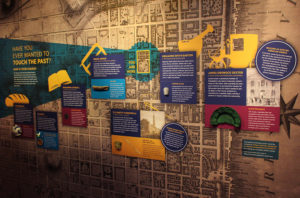 Seventy objects from the vast National Constitution Center site archaeological collection housed in Independence National Historical Park have been selected for use in the newly re-mounted, permanent “We The People” exhibit at the National Constitution Center. A handful of these 70 items were also 3-dimensionally-scanned and then printed and painted by Bernard Means, Director of the Virtual Curation Laboratory at Virginia Commonwealth University (VCU) and his students to make artifact replicas. These replicas are likewise incorporated into the new display where they provide visitors to the exhibit with an opportunity to ‘touch the past’. Sarah Winski (Manager of Exhibit Development, NCC) and Elena Popchock (Exhibit Developer) lead today’s ‘insider’ tours. Thee half-hour tour slots will be offered over the lunch break, scheduled on the half hour starting at noon. Space is limited, so event guests are invited to signed up in advance at the check-in table on the day of the event. Tours will leave from the check-in table promptly at their scheduled times.
Seventy objects from the vast National Constitution Center site archaeological collection housed in Independence National Historical Park have been selected for use in the newly re-mounted, permanent “We The People” exhibit at the National Constitution Center. A handful of these 70 items were also 3-dimensionally-scanned and then printed and painted by Bernard Means, Director of the Virtual Curation Laboratory at Virginia Commonwealth University (VCU) and his students to make artifact replicas. These replicas are likewise incorporated into the new display where they provide visitors to the exhibit with an opportunity to ‘touch the past’. Sarah Winski (Manager of Exhibit Development, NCC) and Elena Popchock (Exhibit Developer) lead today’s ‘insider’ tours. Thee half-hour tour slots will be offered over the lunch break, scheduled on the half hour starting at noon. Space is limited, so event guests are invited to signed up in advance at the check-in table on the day of the event. Tours will leave from the check-in table promptly at their scheduled times.
……………………………………
 1:30pm-1:40pm
1:30pm-1:40pm
Afternoon Welcome/Raffle
Douglas Mooney, President, Philadelphia Archaeological Forum
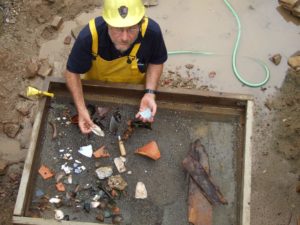 1:40pm-1:55pm
1:40pm-1:55pm
Land of Plenty/Mountains of Trash: ‘Where do all those artifacts come from?’
Urban archeological sites typically produce prodigious numbers of artifacts. Even a small-scale excavation in the city can yield tens of thousands of whole and fragmentary objects. Large sites can produce many more. Archeologists recovered nearly a million artifacts beneath what is now the National Constitution Center, where we are meeting today. In this talk, National Park Service Archeologist Jed Levin attempts to answer the questions: ‘Why so much stuff?’ and ‘Why and how did it all come to get buried here?’
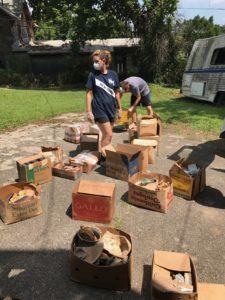
1:55pm-2:10pm
“I have delegated Mr. Joel Goleman…to assist me in salvaging data and objects…”(John L. Cotter, 1969)”
This past year, 53 boxes of 50-year-old salvaged archaeological artifacts were donated to the Philadelphia Archaeological Forum to be used in educating the public about the city’s history. Now to be known as the Goleman Collection, this vast assemblage of mostly ceramic evidence was collected by Joel Bernard Goleman during the late 1960’s when several of the oldest neighborhoods of Philadelphia were being demolished. Goleman was one of several citizens who volunteered to assist the Pennsylvania Historical Salvage Council — a group of history, archaeology, and architectural professionals outraged at the loss of the city’s historical fabric due to the development of I-95 and several federal building projects who were scrambling to record and collect what information could be ‘salvaged’. Goleman’s participation is recorded in documents from the period and his collected materials are used in at least one archaeological report produced by students at the University of Pennsylvania in 1969. This talk, by Philadelphia Archaeological Forum member Patrice L. Jeppson, introduces Joel Goleman, his collection, and the new opportunities for sharing the archaeological past with the public made possible by Goleman’s daughter’s, Myla Rogers and Caren Strong, who wish to have the collection used to extend their father’s historic preservation mission.
2:10pm-2:25pm
The PAF Douglas Heller Award
Recognition of 2017 Recipients — Joel Bernard Goleman; Myla Goleman Rogers and Caren Goleman Strong and their families
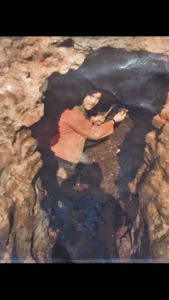
Joel Bernard Goleman, in 1969.
In 2017, the Philadelphia Archaeological Forum recognizes Joel Bernard Goleman for his contribution to the preservation of Philadelphia’s history, as well as his daughters, Myla Goleman Rogers and Caren Goleman Strong and their families, in gratitude for their donation of their father’s salvaged collection to the Philadelphia Archaeological Forum for its use in educational activities that extend the mission of bringing Philadelphians into contact with their past.
Established in 2012, this award recognizes unusual actions or activities of individuals and or organizations that have furthered the cause of, and support for, archaeology in the city of Philadelphia and or its hinterlands. This award was created in honor of Douglas Heller (1955-2012), a member of PAF who also championed the archaeology of the President’s House site at his website USHistory.org, and who developed, and also served as webmaster for (2007-2012), the Philadelphia Archaeological Forum webpages at www.phillyarchaeology.org. Membership in the Philadelphia Archaeological Forum is NOT a requirement for nominee consideration. This award is not bestowed annually.
2:25pm-2:40pm
Up from the Depths (Again): Reviving Old Collections from Bucks County
Archaeological discoveries don’t always come straight out of the ground–sometimes they come from collections of artifacts excavated long ago. Historic preservation students and volunteers from Bucks County Community College (BCCC) have been learning to care for and conduct research in several such collections. In this talk, Megan Ratini, Alice George, and Patricia Harrison introduce these archaeology sites and talk about the collections research on them that is underway at BCCC.
2:40pm-2:55pm
Lightening Round #2
2:40pm-2:43pm
An unexpected Shaft Feature Find of Rare and Unusual Character
During recent archaeological investigations undertaken for PENNDOT, near Race and Water Streets, a series of 18th and 19th century privy shafts (outhouses) were excavated. One of these privy shafts produced a very rare and unusual unexpected Native American artifact – a “knobbed adze”. Jack Cresson, an archaeologist with the cultural resources firm AECOM, will introduce this an axe-like woodworking tool which was made four thousand years ago in Philadelphia’s prehistoric past but found in a more recent setting. He asks the question, What is finding this item here all about?
 2:43pm-2:46pm
2:43pm-2:46pm
Maxwell Sommerville’s “Missing” Collection
Maxwell Sommerville, Professor of Glyptology at Penn and eccentric collector of engraved gems and Buddhist artifacts, donated most of his considerable collection to the Penn Museum at the time of his death in 1904. Included were several hundred Native American artifacts excavated by Sommerville in 1890s at the Minisink Site in the Upper Delaware River Valley. The collection was considered by interested archaeologists to be lost until it was recently relocated and analyzed. (Justin M. Reamer, Ph.D. student, Anthropology Department, University of Pennsylvania/Penn Museum)
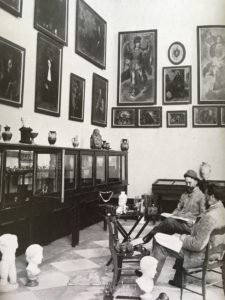 2:47pm-2:50pm
2:47pm-2:50pm
Robert H. Lamborn, Philadelphia’s Renaissance Man
Robert H. Lamborn was a prominent nineteenth century railroad magnate and a man of many interests, including archaeology, history, mining, painting, and insects. As part of this fascination, he collected utilitarian objects from around the world and donated them to many institutions, including the Philadelphia Museum of Art, the Academy of Natural Sciences, and the Penn Museum. After a division of responsibilities among the three Philadelphian institutions, most of Lamborn’s collection has ended up in the Penn Museum. (Sheridan Small, Anthropology Undergraduate, University of Pennsylvania/Penn Museum)
2:51pm-2:54pm
A Perforated Stone-Line Weight or What”?
Last year, archaeologists working near the I-95/Girard Avenue interchange discovered an unusual stone object. The artifact was excavated on the property once comprising the Cramp Shipyard site. While the object appears to be aligned with activities around water, it ‘ain’t’ shipbuilding. Jack Cresson, an archaeologist with the cultural resources firm AECOM, will introduce this newly discovered Native American artifact.
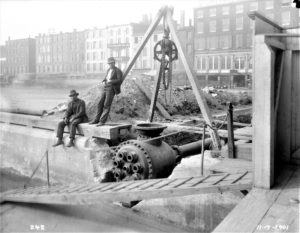
2:55pm-3:10pm
Underground Philadelphia
Harry Kyriakodis will tell us about his upcoming book, Underground Philadelphia, to be released next year by the History Press. Starting with caves that pioneering Quakers once inhabited by the Delaware, the book will delve into the delivery of water, gas, steam, electric and telephone service in Center City. Philadelphia was a national and world leader in most of these utilities. The transit/subway infrastructure of downtown Philly will also be explored in this virtual tour of the secrets beneath the streets of the Quaker City.”
3:10pm-3:30pm
RAFFLE and ASK THE ARCHAEOLOGIST/Questions and Discussion with the Audience
3:30pm Program END
by admin
